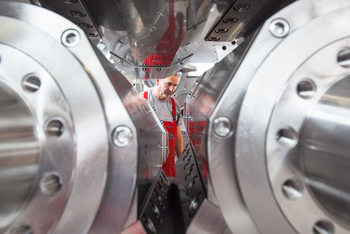Internationalization of production has been a key element in company location planning in the nearly three decades since the end of the Cold War. This globalization of industry has now reached such a level of internationalization that many manufacturers, especially in the automotive industry, produce more in other world regions than in their native country. The major determining factors for location-related decisions – apart from tax and investment advantages – were low wage costs and large labor capacities. In exchange for these advantages, companies accepted decreases in quality and ever-greater distances between goods and sales markets.
We accompanied our customers on their respective individual paths to globalization. As a result, our services became more international and we traveled those great distances along with our customers. SCHOLPP established locations in China and Malaysia 20 years ago to meet the special requirements of our clients. Since that time, however, there has been a notably significant reversal of this trend.
Results of the Miebach study
This trend is also confirmed by the figures from the recently published Miebach study. Companies are increasingly deciding questions of location according to the criteria of the known selection of regional products and a higher level of quality consciousness. Consequently, the current Miebach study shows what SCHOLPP already intuited, which is that production companies also are moving closer to their sales markets.
51 percent of the companies surveyed in the Miebach study are already using production moves to neighboring, close-to-market countries as a location strategy. 26 percent of respondents assessed nearshoring as a future trend, and its importance as high or very high. Nearshoring will gain in importance in Europe in particular, while domestic production, or onshoring, will increase in North America. Companies from various sectors of industry were surveyed in the course of the study.
The trend toward near- and onshoring creates competitive advantages as a result of customer proximity, but also affects supply chains: according to the study participants, these will become more complex. In spite of this, the benefits will outweigh the drawbacks. Shorter supply chains are less susceptible to disruptions, such as supply bottlenecks due to supplier failure or natural disasters, and generate lower logistics and transport costs thanks to shorter distances. Geopolitical risks, for example in crisis regions, or complicated trade restrictions (customs policies) can be reduced or avoided entirely.
Additional advantages of nearshoring are higher quality standards and the possibility of adapting more quickly and flexibly to changing customer requirements and new market requirements. Spatial and cultural proximity creates shorter reaction times. One engine driving this development is the increasing automation of production, propelled onward by the digitalization and networking associated with Industry 4.0. This has led to personnel costs no longer being the determining factor they once were. Instead, close-to-market services and increased quality through automated production are increasingly proving to be competitive advantages.
Custom mix of near- and offshoring leads to success
Nearshoring will, of course, not be able to entirely replace production in distant locations. Each company, in order to be profitable, will have to find its own custom location strategy based on production quantity, price sensitivity, or the proportional cost of labor. Factors such as logistics costs, delivery times, infrastructure, or the availability of skilled labor are just as important to this decision as are feasibility and the costs of relocating production systems or installing machines. SCHOLPP brings all of its expertise to bear to support companies in deciding on and implementing location concepts. Just ask us!
Source: http://www.miebach.com/de/insights/veroeffentlichungen/

